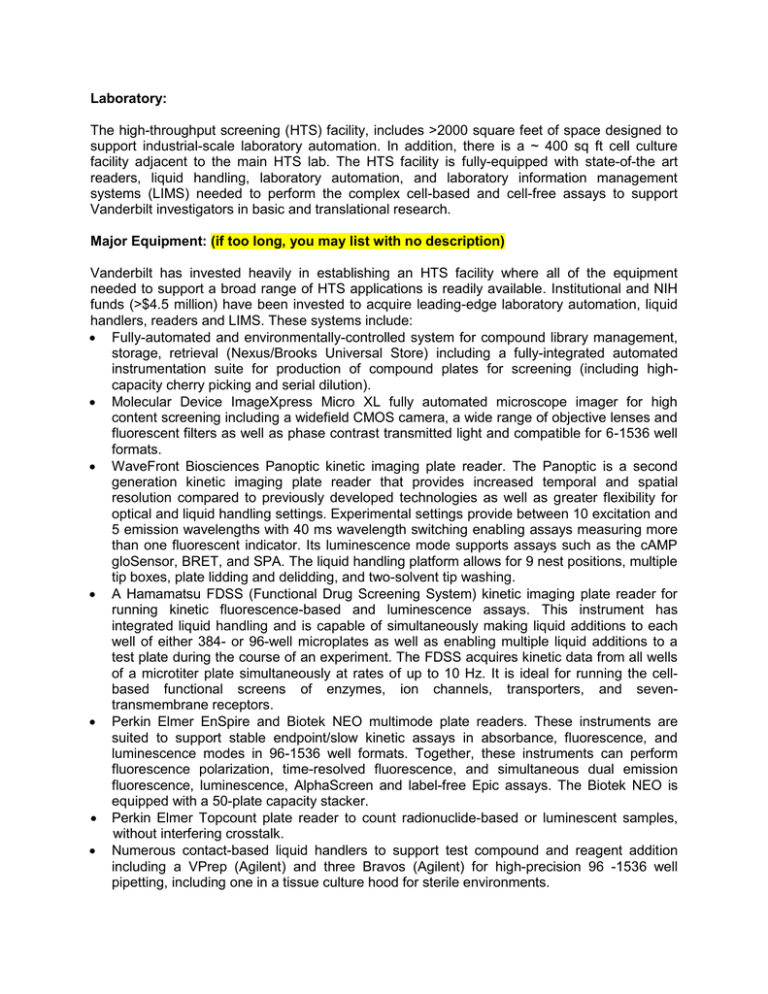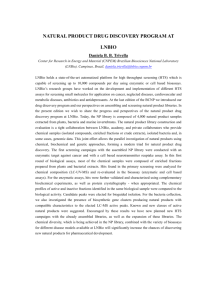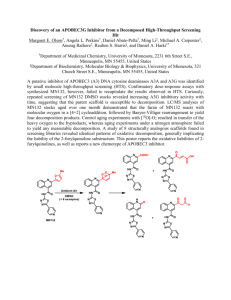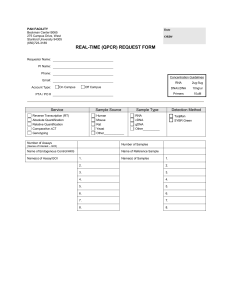Facilities Description - HTS Lab
advertisement

Laboratory: The high-throughput screening (HTS) facility, includes >2000 square feet of space designed to support industrial-scale laboratory automation. In addition, there is a ~ 400 sq ft cell culture facility adjacent to the main HTS lab. The HTS facility is fully-equipped with state-of-the art readers, liquid handling, laboratory automation, and laboratory information management systems (LIMS) needed to perform the complex cell-based and cell-free assays to support Vanderbilt investigators in basic and translational research. Major Equipment: (if too long, you may list with no description) Vanderbilt has invested heavily in establishing an HTS facility where all of the equipment needed to support a broad range of HTS applications is readily available. Institutional and NIH funds (>$4.5 million) have been invested to acquire leading-edge laboratory automation, liquid handlers, readers and LIMS. These systems include: Fully-automated and environmentally-controlled system for compound library management, storage, retrieval (Nexus/Brooks Universal Store) including a fully-integrated automated instrumentation suite for production of compound plates for screening (including highcapacity cherry picking and serial dilution). Molecular Device ImageXpress Micro XL fully automated microscope imager for high content screening including a widefield CMOS camera, a wide range of objective lenses and fluorescent filters as well as phase contrast transmitted light and compatible for 6-1536 well formats. WaveFront Biosciences Panoptic kinetic imaging plate reader. The Panoptic is a second generation kinetic imaging plate reader that provides increased temporal and spatial resolution compared to previously developed technologies as well as greater flexibility for optical and liquid handling settings. Experimental settings provide between 10 excitation and 5 emission wavelengths with 40 ms wavelength switching enabling assays measuring more than one fluorescent indicator. Its luminescence mode supports assays such as the cAMP gloSensor, BRET, and SPA. The liquid handling platform allows for 9 nest positions, multiple tip boxes, plate lidding and delidding, and two-solvent tip washing. A Hamamatsu FDSS (Functional Drug Screening System) kinetic imaging plate reader for running kinetic fluorescence-based and luminescence assays. This instrument has integrated liquid handling and is capable of simultaneously making liquid additions to each well of either 384- or 96-well microplates as well as enabling multiple liquid additions to a test plate during the course of an experiment. The FDSS acquires kinetic data from all wells of a microtiter plate simultaneously at rates of up to 10 Hz. It is ideal for running the cellbased functional screens of enzymes, ion channels, transporters, and seventransmembrane receptors. Perkin Elmer EnSpire and Biotek NEO multimode plate readers. These instruments are suited to support stable endpoint/slow kinetic assays in absorbance, fluorescence, and luminescence modes in 96-1536 well formats. Together, these instruments can perform fluorescence polarization, time-resolved fluorescence, and simultaneous dual emission fluorescence, luminescence, AlphaScreen and label-free Epic assays. The Biotek NEO is equipped with a 50-plate capacity stacker. Perkin Elmer Topcount plate reader to count radionuclide-based or luminescent samples, without interfering crosstalk. Numerous contact-based liquid handlers to support test compound and reagent addition including a VPrep (Agilent) and three Bravos (Agilent) for high-precision 96 -1536 well pipetting, including one in a tissue culture hood for sterile environments. Numerous liquid handlers to support bulk reagent addition and cell plating in 96-1536 well plates including six Multidrop Combis (Thermo Fisher) with one contained in a tissue culture hood Various other instruments to support the proposed research including two VSpin (Velocity11) automated plate centrifuges, two Cytomat2 (Kendro) automated cell culture incubators, PlateLoc (Agilent) plate sealer, two Elx405CW (Bio-Tek) plate washers, XCap tube decapper (Brooks), and XPeel plate desealer (Brooks). Two Echo555 (Labcyte) acoustic plate reformatters. These revolutionary, non-contact, ultralow volume (2-1000 nl), random-access liquid handlers are ideal for compound management and presentation for both cell-based functional assays and for low volume scintillation proximity assays (SPA).One of these instruments is calibrated for DMSO solutions. The other is calibrated for an array of solvents allowing the transfer of genomic reagents, biochemical reagents and buffers. Seahorse XFe96 Extracellular Flux Analyzer. This device simultaneously interrogates the two major energy-producing pathways of the cell – mitochondrial respiration and glycolysis. The Analyzer determines in vitro oxygen consumption rate (OCR) and extracellular acidicfication rate (ECAR), in order to assess cellular functions such as oxidative phosphorylation, glycolysis, and fatty acid oxidation. Three robotically integrated systems support high-content imaging (Molecular Devices ImageXpress Micro XL and supporting instruments), kinetic imaging plate reading (Hamamatsu FDSS and supporting instruments), and compound plate creation (Labcyte Echo 555 and supporting instruments), Plate movement between instruments occurs through a Thermo Scientific F3 six-axis articulated robotic arm controlled by Thermo Scientific Momentum scheduling software. This enables walk-away assay execution with time-locked, trackable events. All readers on the system are connected via intranet to the facility’s network enabling automated data acquisition, analysis, visualization, and archival using a variety of commercially acquired and in-house designed data management and informatics tools including Accelrys Pipeline Pilot, Accelrys Accord, Microsoft SharePoint, DeltaSoft’s ChemCart suite, and WaveGuide, an inhouse data analysis application. All data are stored in an Oracle database. The facility’s data management infrastructure will support data deposition into external databases including PubChem and D360. Compound Collections: The Vanderbilt Screening Facility utilizes an ever-growing compound collection designed and deployed to enable a wide-variety of screening modalities from assay development and pilot screen to large-scale high-throughput screening (Tables 1 and 2). Our latest addition to our diverse screening collection includes a 100,000 small molecule library (Life Chemicals) that was selected by a team of medicinal and computational chemists to ensure diversity and minimize the number of compounds identified as likely yielding false positive results due to their containing known reactive groups or scaffolds identified to be promiscuous inhibitors. Our VICB discovery collection totals ~160,000 compounds; this library was obtained from ChemBridge and ChemDiv and were chosen to maximally represent the chemical diversity of the larger compound collections (~1.2 million samples in total). A 77,000 member selection from the MLPCN compound library is available for screening. Table 1 VHTS Diverse Screening Collections NAME # COMPOUNDS DESCRIPTION Vanderbilt Discovery Collection 100,000 Selected from Life Chemicals collection for HTS. The compounds in this collection were chosen by Vanderbilt medicinal and computational chemists to provide leadlike motifs, minimum pan-assay interference, and maximum diversity. VICB Collection 160,000 Drug-like, diverse set of small molecules from Chembridge and ChemDiv Molecular Libraries Small Molecule Repository (MLSMR)* 77,000 Recent acquisition for MLPCN screens; requires screening results deposition into Pubchem Fesik Fragment Library 16,000 Diverse collection of fragment molecules from 8 vendors, rule of 3 compliant, and filtered against non-specific and interfering molecules. Other libraries include several collections from the NCI including the approved oncology set, a 51-member epigenetics collection (SelleckChem), 6200-member ion channel library (Life Chemicals), Spectrum Collection (Microsource), the NIH Clinical Collections I and II (DPI), Roche Published Kinase Inhibitor Collection, GSK Kinase Inhibitor Collection, Enzo Screen-well kinase inhibitor library, and an 800-member NCI purified natural products collection. In partnership with the Vanderbilt Synthesis Core, the size and diversity of the library via internal and external efforts in both synthetic and technology-enable natural products isolation is continually growing. Table 2 VHTS Targeted Collections NAME # COMPOUNDS DESCRIPTION 119 contains most current FDA-approved anticancer drugs. The current set (AOD VI) consists of 119 agents and is intended to enable cancer research, drug discovery and combination drug studies. Diversity Set V 1593 During the generation of the diversity set, the pharmacophores for any candidate compound are compared to the set of all pharmacophores found in structures already accepted into the set. If the current structure has more than 5 new pharmacophores, it is added to the set. An additional objective with the NCI Diversity Set III was to create a diverse set of compounds that were amenable to forming structure-based hypotheses. Mechanistic Set III 813 was derived from the 37,836 open compounds that have been tested in the NCI human tumor 60 cell line screen. In contrast to the original diversity set of 1,990 compounds, which was chosen on the basis of structural diversity Natural Product Set III 117 This set was created in response to numerous drug discovery research groups that expressed a desired to study a variety of scaffold structures having multiple functional groups. NCI Focused Natural Product Collection 819 Pure compounds acquired by the NCI from Analytical and MerLion Approved Oncology Drugs Set VI Spectrum Collection NIH Clinical Collection I and II Cayman Lipid Library Marnett Collection Ion Channel Epigenetics Collection Enzo Kinase Inhibitor Library 2,000 730 1,000 215 >6000 A wide range of biologically active and structurally diverse compounds. 50% drug components, 30% natural products, 20% other bioactive components. Small molecules that have history of use in human clinical trials. Broad variety of bioactive lipids. NSAID derivatives that contain cyclooxygenase inhibitors, PPARgamma activators and apoptosis inducers. A collection from Life Chemicals targeted to ion channels compiled using 2D fingerprint similarity methodology. 51 A group of small molecule modulators with biological activity for use in epigenetic research. 80 The Screen-Well™ Kinase Inhibitor Library contains 80 known kinase inhibitors of well-defined activity. Includes inhibitors of these important kinases: Insulin/IGF Receptors, PI 3-Kinase, CaM Kinase II, JAK, PKA, CDK, JNK, PKC, CKI II, MAPK, RAF, EGFR, MEK, SAPK, GSK, MLCK, Src-family, IKK, PDGFR, VEGFR, and many more. GSK Published Kinase Inhibitor Library* 349 A set of 349 small molecule kinase inhibitors spanning over 30 chemotypes that have been previously published by GlaxoSmithKline in peer-reviewed scientific journals. Roche Published Protein Kinase Inhibitor Library* 235 Small molecule protein kinase inhibitors disclosed in peer-reviewed scientific publications. * requires collaborative agreement with supplier siRNA Libraries: In 2013, the HTS Facility expanded screening capabilities to the genomic level by adding several human siRNA libraries (Dharmacon). These are available in 96 or 384-well plates in a ready-to-transfect format. Included in this collection are pooled kinase, individual kinase, pooled druggable genome, and whole-genome libraries. Personnel: Paige Vinson, Ph.D.: Director and Research Assistant Professor of Biochemistry C. David Weaver, Ph.D.: Scientific Director and Associate Professor of Pharmacology Joshua Bauer, Ph.D.: Director of High-content Imaging and Functional Genomic Screening, Research Assistant Professor of Biochemistry Chris Farmer, Ph.D.: Director of Screening Informatics Emily Days: Drug Discovery Scientist Debbie Mi, Ph.D.: Drug Discovery Scientist Corbin Whitwell: Compound Management Specialist Erin Gribben: Scientific Research Core Facility Coordinator Mike McCaughey, Ph.D.: Automation Engineer, Research Assistant Professor Lisa Wright: Core Manager Matthew Graves: Software Programmer David Baughman: Computer Systems Administrator






